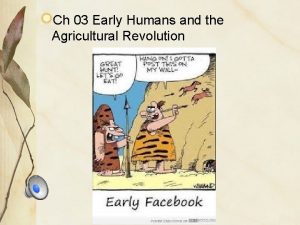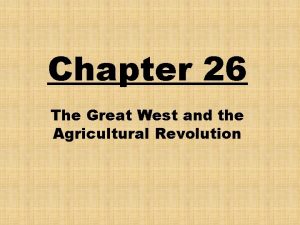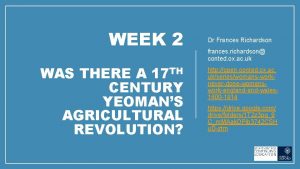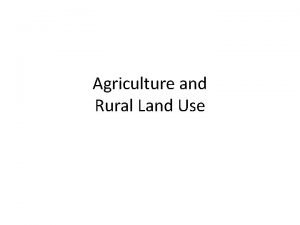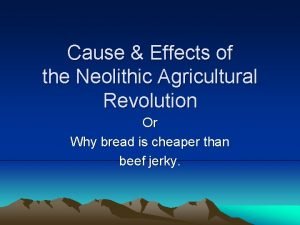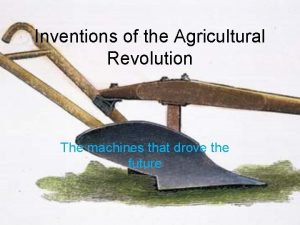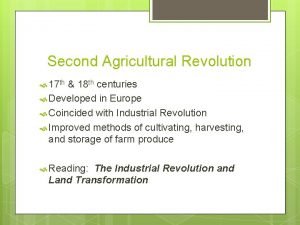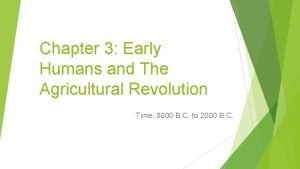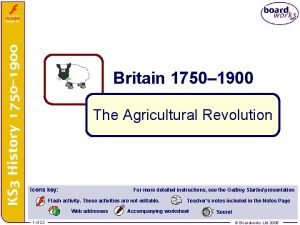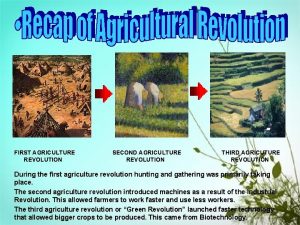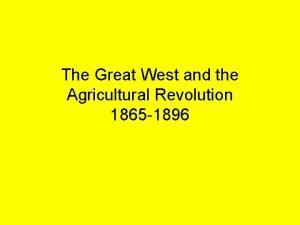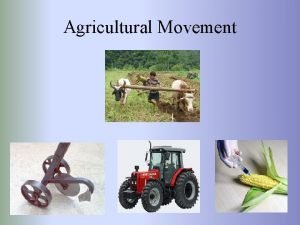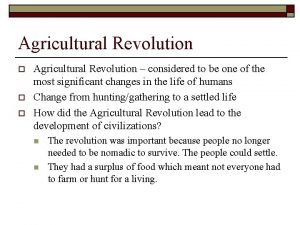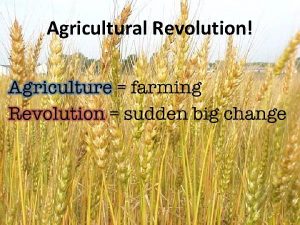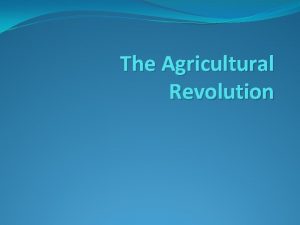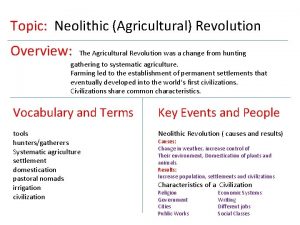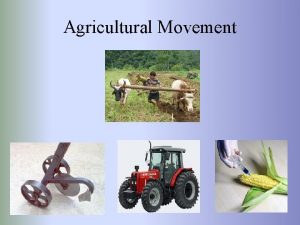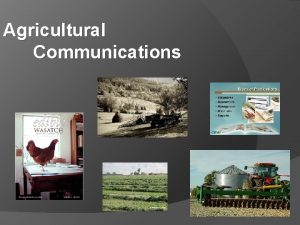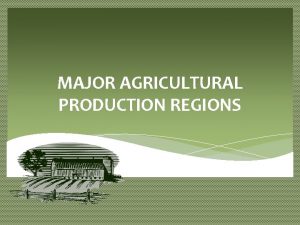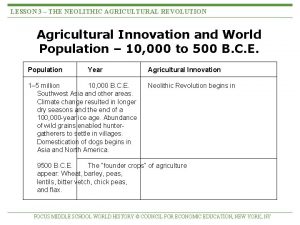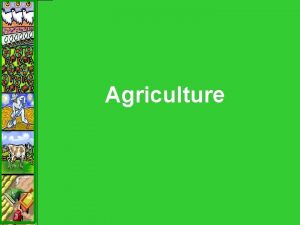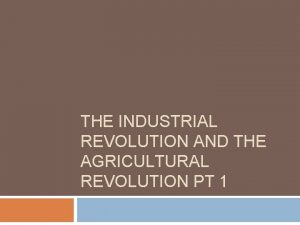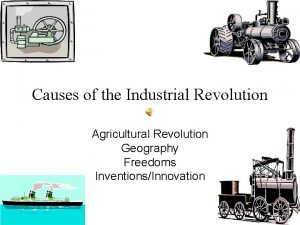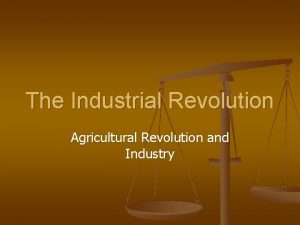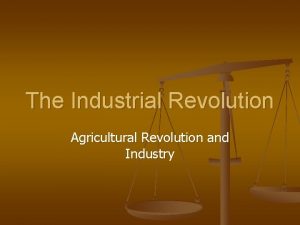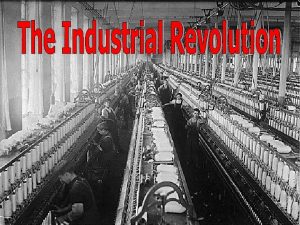The Agricultural Revolution 17 th 18 th c

































- Slides: 33

The Agricultural Revolution (17 th & 18 th c. )

The State of Agriculture in 1700 • Peasants and artisans had about the same standard of living as in the Middle Ages • Most people battled hunger and lacked sufficient clothing and decent housing • Agriculture had changed little since the Middle Ages • 80% of western Europe's population were farmers; percentage was even higher in eastern Europe • The Netherlands was the only exception; more urban and mercantile

Agricultural Output • Agricultural output was very low compared to modern standards • Medieval open field system was predominant • Failed harvests occurred once or twice a decade, on average, resulting in famines • People were malnourished, making them more susceptible to disease • Science was essentially a branch of theology and had no real application in agriculture

Open Field System • Common lands were open and strips of land for agriculture were not divided by fences or hedges • Open fields were farmed as a community • Agriculture in villages changed little from generation to generation; based largely on community and family traditions • Exhaustion of soil was a common problem • Eventually, 1/3 to 1/2 of lands were allowed to lie fallow on any given year so that the soil could recover • Villages maintained open meadows for hay and natural pasture • Peasants were often taxed heavily • Serfs in eastern Europe were far worse off than farmers in western Europe

Change Begins in the West • In the 18 th century, England, the Netherlands and France became leaders for increased agriculture, industry and trade that resulted in population growth

Features of the Agricultural Revolution • Increased production of food • Increased crop and animal yields could feed more people • New methods of cultivation • Crops were grown on wastelands and uncultivated common lands • Selective breeding of livestock • Led to better cultivation as a result of healthier animals

Science and Technology Applied • The Low Countries led the way • Increased population meant that finding new methods of agricultural became paramount • Growth of towns and cities created major markets for food produced in the countryside • Regional specialization in the Netherlands resulted: certain areas for farming, certain regions for fishing and shipping; towns and cities for mercantile activities

Dutch Advances • By mid-17 th century, the Dutch enclosed fields, rotated crops, employed heavy use of manure for fertilizer and planted a wide variety of crops • Free and capitalistic society provided profit incentives for farmers to be productive • Drainage • Much of Holland had once been marshland or covered by ocean waters • The Dutch became world leaders in reclaiming wetlands through drainage • Cornelius Vermuyden was the most famous of the Dutch engineers in drainage techniques • Drainage was later used extensively in southern England to create new farm lands

English Advances • By 1870, crop yields hadtripled since 1700 with only a 14% increase in people working the land • Charles Townshend pioneered crop rotation • As English ambassador to the Netherlands, he witnessed Dutch use of nitrogen-rich crops such as turnips and clover to replenish soil so that fallowing was not necessary • Townshend later drained much land back at home in England • Employed crop rotation: turnips, peas, beans, clover and potatoes • Some nicknamed him "Turnip" Townshend • Enriched soil provided more food for livestock • Manure was used for fertilizer

Livestock Gains • Increased food for livestock meant mass slaughter of animals was no longer needed prior to winter • Animal feed was now available to sustain livestock through the winter • People ate more fresh meat rather than preserving surplus meat through salting

Jethro Tull’s Seed Drill • By 1740, new agricultural techniques had become popular among much of the English aristocracy • Jethro Tull (1674 -1741) • Good example of how the empiricism of the scientific revolution was applied to agriculture • His seed drill allowed for sowing of crops in a straight row rather than scattering it by hand. • Used horses for plowing rather than slower oxen

Robert Bakewell • Robert Bakewell (1725 -95) pioneered selective breeding of livestock • Larger and healthier animals were developed • Resulted in increased availability of meat, wool, leather, soap and candle tallow • More manure became available for fertilizing

New Foods • New foods: the Columbian exchange resulted in a revolution in diet • New foods from the New World became increasingly available in the 17 th and 18 th centuries • Potatoes and corn were among the most important: highly nutritious and relatively easy to grow.

The English Enclosure Movement • Began in the 16 th century • Landowners sought to increase profits from wool production by enclosing fields for raising sheep • Differed from 18 th century enclosure that was based largely on agriculture • Enclosure of fields intensified in the 18 th century • End to the open field system • Landowners consolidatedtheir scattered holdings into compact fields that were fenced • Common pasture lands were also enclosed

Consequences of Enclosure • Resulted in the commercialization of agriculture • Large landowners prospered and invested in technology (machinery, breeding, cultivation methods) • Increased number of large and middle-sized farms • Parliament passed over 3, 000 enclosure acts in the late-18 th century and early 19 th-century that benefited large landowners

Corn Laws • Corn Laws in 1815 benefited landowners • High tariffs placed on foreign grain • Drove up the price of English grain in England • Hurt the poor as they couldn't afford price increases for food • One of most notorious examples of a law that benefited the wealthy at the expense of the English peasantry

Enclosure’s Impact on Peasants • Many were forced off lands that had once been common • Many moved to towns or cities looking for work since work was less available in the countryside • Many found work in factories or in poor houses • Many became impoverished farm laborers • In some cases, enclosure freed men to pursue other economic opportunities, such as the cottage industry • Women now had no way to raise animals on common lands for extra money

Impact on Women • In traditional communities, women had been an indispensable part of a household's economic survival • Women farmed, raised animals and oversaw important functions of the household • Enclosure of common lands meant that women (and men) were forced off the land • Economic opportunities for women thus decreased significantly • Many families with daughters were eager to get them out of the house as they were an extra mouth to feed • Young women increasingly went to towns or cities where they became domestic workers, or in many cases when there were no alternatives, prostitutes. • Families who were able to get by in the countryside often supplemented their income through the cottage industry, or putting-out system (mostly for spinning or weaving) • Women played an important role in spinning and weaving

Changes in Hierarchy • A strict hierarchical system emerged • A few landowners (gentry) dominated the economy and politics • Strong and prosperous tenant farmers rented land from the large landowners • Some small peasant farmers owned their own land • A huge number of peasants became wage earners on farms or in the cottage industry

Class Struggles • Struggles between landowners and peasants occurred • Game laws were passed on behalf of landowners whereby animals on owners' vast lands could not be hunted for food • Peasants who were without food would risk severe punishment if they were caught hunting for food on an owner's land

Impact of the Enclosure Movement? • Traditional view • Enclosures pushed thousands of peasants out of the countryside or resulted in abject poverty for those who remained • Theory put forth by the socialist Karl Marx in the 19 th century

Impact of the Enclosure Movement? • More recent research • Negative effects of enclosure are exaggerated • Many thousands remained in the countryside working as prosperous tenant farmers, small landowners or wage earners. • As much as 50 percent of England's farmland was already enclosed by 1750 • In 1700 there was a ratio of two landless laborers for every self-sufficient farmer; that number was not significantly larger by 1750 • In the late 17 th and early 18 th century lands were enclosed by mutual agreement between all classes of landowners in villages

Uniquely English • Enclosure did not spread significantly to western Europe • France did not develop enclosure as national policy and after the 1760 s peasants in the provinces strongly opposed enclosure • Eastern Europe did not see fundamental agricultural changes until the 19 th century

Impact of the Agricultural Revolution • Led to Europe's population explosion in the 18 th century • The Enclosure movement altered society in the countryside • Common lands were enclosed thus changing traditional village life • Widespread migration to cities resulted in urbanization • Women were adversely affected • The cottage industry emerged as a means of supplementing a farm family's income • Economically, the increased supply of food resulted in lower food prices that enabled people to spend more money on consumer goods.

Population Explosion • Limits on population growth prior to 1700: • Famine, disease and warfare kept population growth in check • Not until the mid-16 th century did Europe's population reach pre-Black Death levels of the early 1300 s. • Population growth reached a plateau between 1650 and 1750 but began to grow dramatically after 1750. • Between 1700 and 1800 the European population increased from about 120 million to about 190 million people.

Causes For Population Growth • Agricultural revolution made more food available to larger populations • New foods such as the potato became a staple crop for the poor in many countries (e. g. Ireland) • Improved food transportation due to better roads and canals • Better diet resulted in stronger immune systems in people to fight disease • Disappearance of the bubonic plague after 1720 • Improved sanitation in towns and cities • 18 th century wars were less destructive on civilian populations • Advances in medicine was NOT a significant cause

Proto-Industrialization: the Cottage Industry ("Putting-Out" System) • Rural industry became a major pillar of Europe's growing economy in the 18 th century • Rural population was eager to supplement its income • Merchant-capitalists in cities were eager to draw on cheap labor in the countryside rather than paying guild members in towns higher fees • Thus, early industrial production was "put out" into the countryside: the "putting-out system" • Manufacturing with hand tools in peasant cottages came to challenge the urban craft industry

Cottage Industry • Merchant-capitalists would provide raw materials (e. g. raw wool) to a rural family who produced a finished or semi-finished product and sent it back to the merchant for payment • Cottage workers were usually paid by the number of pieces they produced • Merchants would sell the finished product for a profit • Wool cloth was the most important product

A Family Business • The Cottage industry was essentially a family enterprise. • Work of four or five spinners needed to keep one weaver steadily employed. • Husband wife constantly tried to find more thread and more spinners. • "Spinsters“ were widows and unmarried women who spun for their living. • Sometimes, families subcontracted work to others

Problems With the Cottage Industry • Constant disputes between cottagers and merchants occurred over weights of materials and quality of cloth. • Rural labor unorganized and usually difficult for merchants to control. • Merchant-capitalists' search for more efficient methods of production became profound resulting in growth of factories and the industrial revolution.

Results • Thousands of poor rural families were able to supplement their incomes • Unregulated production in the countryside resulted in experimentation and the diversification of goods • Goods included textiles, knives, forks, housewares, buttons, gloves, clocks and musical instruments

English Cottage Industry • The cottage industry flourished first in England • Spinning and weaving of woolen cloth was most important • In 1500, half of England's textiles were produced in the countryside • By 1700, that percentage was higher • The putting-out system in England spread later to Continental countries (e. g. France and Germany)

Technological Innovation • Proto-industrialism technology (prior to steam engine) • 1733, John Kay invented the flying shuttle which enabled weaver to throw shuttle back and forth between threads with one hand. • 1764, James Hargreaves invented the spinning jenny which mechanized the spinning wheel. • 1769, Richard Arkwright invented the water frame, which improved thread spinning. • 1780 s, Arkwright used steam engine to power looms which required factory production of textiles. • Many historians consider this the beginning of the industrial revolution • 1779, Samuel Crompton invented the spinning mule which combined the best features of the spinning jenny and the water frame.
 Third agricultural revolution
Third agricultural revolution Early humans and the agricultural revolution answer key
Early humans and the agricultural revolution answer key Agricultural revolutions ap human geography
Agricultural revolutions ap human geography Chapter 26 the great west and the agricultural revolution
Chapter 26 the great west and the agricultural revolution The agricultural revolution
The agricultural revolution Green revolution advantages and disadvantages
Green revolution advantages and disadvantages Whittlesey agricultural regions
Whittlesey agricultural regions Cause and effect of neolithic revolution
Cause and effect of neolithic revolution Agricultural revolution inventions
Agricultural revolution inventions The second agricultural revolution coincided with
The second agricultural revolution coincided with Chapter 3 early humans and the agricultural revolution
Chapter 3 early humans and the agricultural revolution Agricultural revolution worksheet
Agricultural revolution worksheet The second agricultural revolution
The second agricultural revolution The great west and the agricultural revolution
The great west and the agricultural revolution The rise of civilization lesson 2 the neolithic revolution
The rise of civilization lesson 2 the neolithic revolution Did american revolution cause french revolution
Did american revolution cause french revolution Russian revolution vs french revolution
Russian revolution vs french revolution Bổ thể
Bổ thể Từ ngữ thể hiện lòng nhân hậu
Từ ngữ thể hiện lòng nhân hậu Tư thế ngồi viết
Tư thế ngồi viết Thế nào là giọng cùng tên?
Thế nào là giọng cùng tên? Thể thơ truyền thống
Thể thơ truyền thống Alleluia hat len nguoi oi
Alleluia hat len nguoi oi Hươu thường đẻ mỗi lứa mấy con
Hươu thường đẻ mỗi lứa mấy con Diễn thế sinh thái là
Diễn thế sinh thái là đại từ thay thế
đại từ thay thế Vẽ hình chiếu vuông góc của vật thể sau
Vẽ hình chiếu vuông góc của vật thể sau Công thức tính thế năng
Công thức tính thế năng Phép trừ bù
Phép trừ bù Tỉ lệ cơ thể trẻ em
Tỉ lệ cơ thể trẻ em Thế nào là mạng điện lắp đặt kiểu nổi
Thế nào là mạng điện lắp đặt kiểu nổi Lời thề hippocrates
Lời thề hippocrates Vẽ hình chiếu đứng bằng cạnh của vật thể
Vẽ hình chiếu đứng bằng cạnh của vật thể Quá trình desamine hóa có thể tạo ra
Quá trình desamine hóa có thể tạo ra

